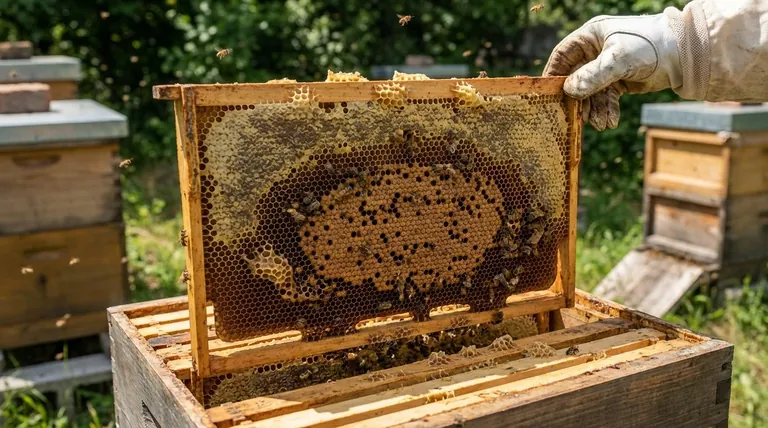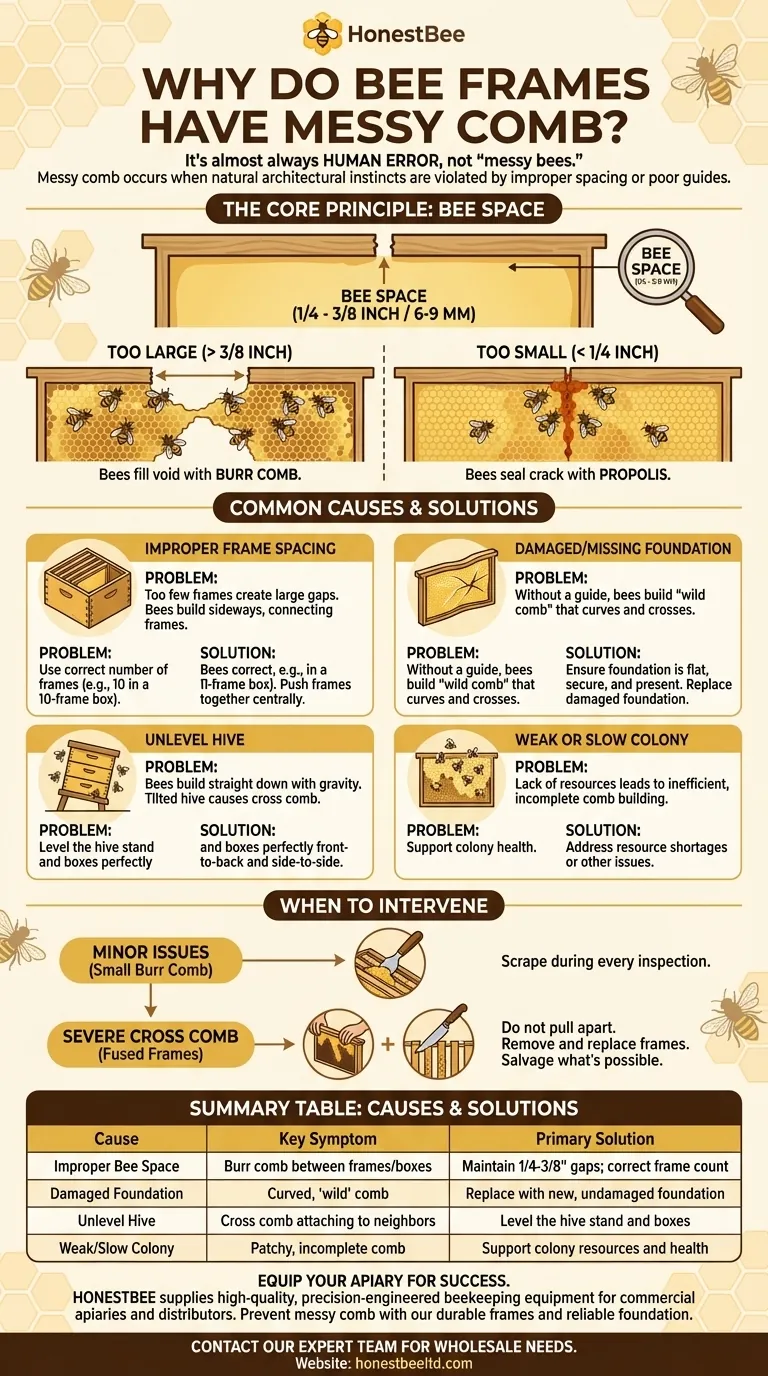In short, messy bee comb is almost always a human error. It occurs when bees are given improper spacing, poor structural guides, or are otherwise forced to deviate from the remarkably consistent patterns they follow in nature. The most common causes are incorrect "bee space" between frames, damaged or missing foundation, or an unlevel hive.
Messy comb is not a sign of "messy bees." It is a symptom of a hive environment that has violated their natural architectural instincts. Understanding and respecting the principle of "bee space" is the single most important factor in promoting straight, clean, and functional comb.

The Core Principle: Understanding "Bee Space"
To prevent messy comb, you first have to understand the fundamental rule of beehive architecture: bee space. This concept, discovered by L.L. Langstroth in 1851, is the foundation of all modern beekeeping.
What is Bee Space?
Bee space is a specific gap, ranging from 1/4 to 3/8 of an inch (6-9 mm), that bees will consistently leave open as a walkway. They instinctively keep this precise amount of space clear.
Any deviation from this measurement triggers a specific building behavior. Understanding this is key to managing your hive.
When Space is Too Large
If a gap is larger than 3/8 of an inch, bees will perceive it as a void that needs to be filled. They will build extra "burr comb" or "brace comb" to connect the two surfaces.
This is the primary cause of comb being built between frames, between boxes, or connecting a frame to the hive wall, creating a mess that makes inspections difficult.
When Space is Too Small
If a gap is smaller than 1/4 of an inch, bees see it as a useless crack. They will seal it shut with propolis, a sticky plant resin.
This is why frames can become glued to the hive body or to each other, making them difficult to remove without causing damage.
Common Causes of Irregular Comb
With the principle of bee space in mind, the direct causes of messy comb become clear. They are almost always preventable issues related to the hive's physical setup.
Improper Frame Spacing
This is the most common culprit. If your hive box holds 10 frames, it must contain 10 frames. Using only 9 frames in a 10-frame box creates gaps that are too wide.
The bees will follow their instincts and fill these large gaps by drawing comb out sideways, often connecting multiple frames into a single, unmovable block of wax.
Damaged or Missing Foundation
Foundation—the sheet of plastic or wax placed inside a frame—acts as a guide. It encourages bees to build straight comb within the confines of the frame.
If the foundation is warped, slips, or is missing entirely, the bees are left to build "wild comb." Without a guide, this comb often curves and crosses into the space of adjacent frames.
An Unlevel Hive
Bees use gravity as a reference point for building their comb perfectly vertical. If the entire hive is tilted forward, backward, or to one side, the bees will still build straight down.
This can cause the bottom of the comb to attach to the neighboring frame, creating what is known as cross comb.
Weak or Slow-Building Colony
During a weak nectar flow or with a small colony, bees may not have the resources to draw out an entire frame quickly.
This can result in patchy, incomplete comb. While not necessarily "messy" in a structural sense, it is inefficient and can be a sign that the colony needs support.
Understanding the Trade-offs: When to Intervene
A little bit of burr comb is normal, but widespread messy comb is a serious problem that requires action. Ignoring it will only make the problem worse over time.
The Problem with Ignoring Messy Comb
Irregular comb makes hive inspections nearly impossible. You cannot check for the queen, assess brood patterns, or look for disease if you cannot pull the frames.
Furthermore, the uncontrolled voids created by messy comb can become hiding places for pests like wax moths and small hive beetles.
How to Fix Minor Issues
Small amounts of burr comb built between the top bars of frames or between hive boxes can and should be scraped away with your hive tool during every inspection.
Removing it when it's small prevents it from becoming a major structural problem.
When to Scrap a Frame
If frames are severely cross-combed and fused together, do not try to pull them apart. This will destroy the comb, kill brood, and spill honey, which can incite robbing.
The best course of action is to wait for a cool day, remove the entire block of fused frames, and cut them apart. Salvage any honey you can, but the comb and brood are often a loss. It is almost always better to replace the bad frames with new foundation and start over.
How to Ensure Straight, Clean Comb in Your Hive
Your goal as a beekeeper is to create an environment that channels the bees' natural instincts into building a hive that is both productive for them and manageable for you.
- If your primary focus is starting a new hive: Ensure your hive stand is perfectly level and your boxes are assembled squarely. Always use the correct number of frames (10 in a 10-frame box, 8 in an 8-frame box) and push them together firmly in the center of the box.
- If your primary focus is managing an existing hive: During every inspection, scrape off any burr comb you find. Pay close attention to frame spacing, especially after removing frames and putting them back.
- If your primary focus is correcting a messy frame: For minor issues, you can trim the errant comb. For severe cross comb, it is more efficient to remove the frame entirely and replace it with a new one.
By managing space and providing clear guides, you empower your bees to build the efficient, organized home they are naturally driven to create.
Summary Table:
| Cause of Messy Comb | Key Symptom | Primary Solution |
|---|---|---|
| Improper Bee Space | Burr comb between frames/boxes | Use correct number of frames; maintain 1/4-3/8" gaps |
| Damaged/Missing Foundation | Curved, "wild" comb | Replace with new, undamaged foundation |
| Unlevel Hive | Cross comb attaching to adjacent frames | Level the hive stand and boxes |
| Weak/Slow Colony | Patchy, incomplete comb | Support colony with resources; check for health issues |
Stop struggling with messy comb and equip your apiary for success.
At HONESTBEE, we supply commercial apiaries and beekeeping equipment distributors with the high-quality, precision-engineered supplies needed to maintain optimal hive conditions. From durable frames and reliable foundation to essential hive tools, our wholesale-focused operations ensure you have the right equipment to prevent messy comb and promote strong, productive colonies.
Contact our expert team today to discuss your wholesale needs and ensure your hives are built for straight, manageable comb.
Visual Guide

Related Products
- Assembled Wooden Bee Frames with Beeswax Foundation Ready to Use by HONESTBEE
- Plastic Bee Frame Beekeeping Hive Frames for Wholesale
- HONESTBEE Wired and Assembled Wooden Bee Frames Foundation for a Thriving Hive
- Heart-Shaped Comb Honey Frame and Honeycomb Cassette
- Assembled Wooden Bee Frames with Plastic Foundation for Durability and Convenience by HONESTBEE
People Also Ask
- Can old bee frames be reused? Weighing the Risks vs. Rewards for Your Hive
- Can I reuse old frames? A practical guide to saving money and reducing waste
- What are the main parts of a hive frame? A Guide to Modern Hive Anatomy
- What are the advantages of using wooden beehive frames? Natural, Sustainable, and Bee-Friendly
- When should I throw away my bee frame? A Guide to Hive Health & Frame Rotation



















